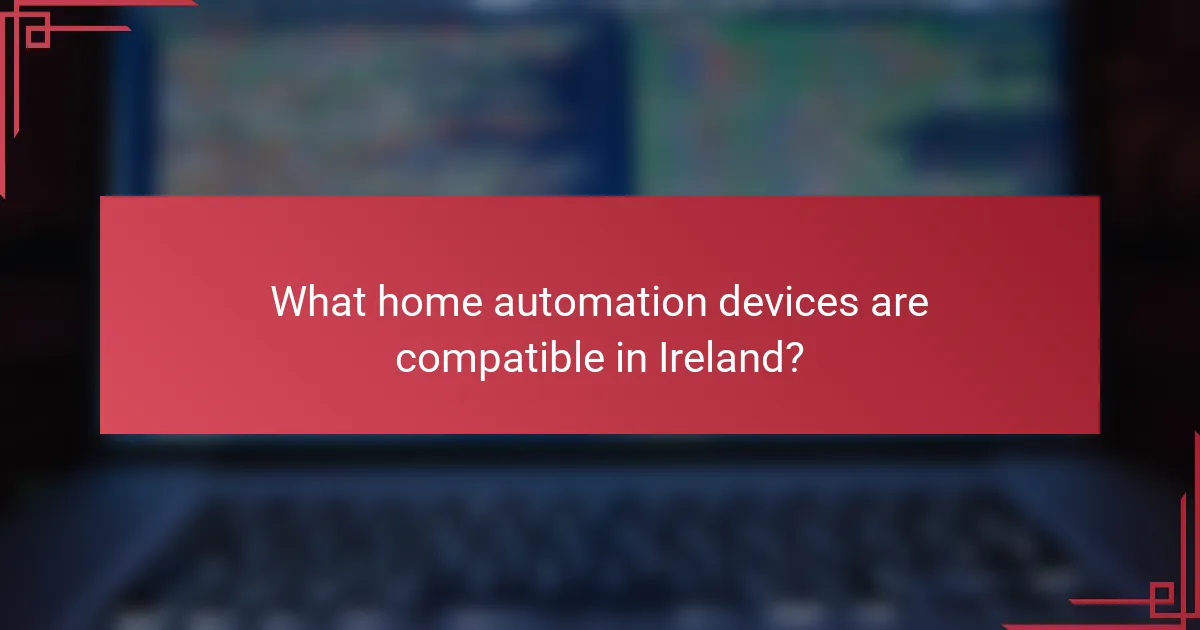When setting up a smart home in Ireland, it’s crucial to ensure that your home automation devices are compatible with local networks and standards. By verifying Wi-Fi standards, hub requirements, and app compatibility, you can avoid connectivity issues and enhance the overall performance of your smart home ecosystem.

What home automation devices are compatible in Ireland?
In Ireland, many home automation devices are compatible with local networks and standards, allowing for seamless integration into smart homes. Key categories include smart speakers, thermostats, lighting systems, and security cameras, each with specific compatibility considerations.
Smart speakers like Amazon Echo
Smart speakers such as the Amazon Echo are widely compatible in Ireland, supporting various streaming services and smart home integrations. They typically connect via Wi-Fi and can control other smart devices through voice commands.
When selecting a smart speaker, ensure it supports the local language and regional services. Check compatibility with other devices you plan to use, as some features may vary based on the device ecosystem.
Smart thermostats such as Nest
Smart thermostats like Nest are designed to optimize heating and cooling in homes across Ireland. They learn user preferences and can be controlled remotely via smartphone apps, making them convenient for energy management.
Before purchasing, verify that the thermostat is compatible with your existing heating system, whether it’s gas, oil, or electric. Additionally, consider any local regulations regarding energy efficiency that may influence your choice.
Smart lighting systems like Philips Hue
Philips Hue smart lighting systems are popular in Ireland for their flexibility and ease of use. They allow users to control lighting through apps or voice commands, creating customizable atmospheres in homes.
Ensure your Wi-Fi network can support the number of bulbs you plan to install, as each requires a connection. It’s also beneficial to check if the lighting system integrates with other smart home devices you own.
Smart security cameras from Ring
Ring smart security cameras are effective for monitoring homes in Ireland, offering features like motion detection and real-time alerts. They connect to Wi-Fi and can be accessed through mobile apps for easy surveillance.
When choosing a security camera, consider the camera’s resolution, field of view, and storage options. Verify that it complies with local privacy regulations, especially regarding video recording in public spaces.

How to check compatibility of devices?
To ensure your home automation devices work seamlessly together, start by checking their compatibility with your existing systems. This involves verifying Wi-Fi standards, hub requirements, and app compatibility to avoid connectivity issues.
Verify Wi-Fi standards
Different home automation devices may support various Wi-Fi standards, such as 802.11n, 802.11ac, or the newer 802.11ax. Ensure that your router and devices are compatible with the same standard to maintain optimal performance and connectivity.
For example, if your device only supports 802.11n, it may not function properly on a network that primarily uses 802.11ac. Check the specifications of each device and your router to confirm compatibility.
Check for hub requirements
Some smart devices require a specific hub to function correctly, while others can operate independently. Before purchasing, verify whether a hub is needed and if so, ensure it is compatible with your existing devices.
For instance, devices from brands like Philips Hue or Samsung SmartThings often require their respective hubs. If you already own a hub, check its compatibility with any new devices you plan to add to your system.
Review app compatibility
Many home automation devices are controlled via mobile apps, which may not be compatible across different brands. Before buying a device, check if it can be integrated into your existing app ecosystem.
For example, if you use the Google Home app, ensure that any new devices you consider can be controlled through it. This will simplify management and enhance your overall user experience.

What are the best practices for device integration?
To ensure seamless integration of home automation devices, it’s essential to follow best practices that enhance compatibility and performance. Key strategies include using a central hub, keeping firmware updated, and adhering to manufacturer guidelines.
Use a central hub like Samsung SmartThings
A central hub, such as Samsung SmartThings, acts as the brain of your smart home, allowing various devices to communicate with each other. This integration simplifies control and enhances functionality, as devices from different manufacturers can work together efficiently.
When selecting a hub, consider compatibility with your existing devices and the range of supported protocols, such as Zigbee, Z-Wave, and Wi-Fi. A well-chosen hub can streamline your automation setup and reduce the need for multiple apps.
Ensure firmware is up to date
Keeping the firmware of your home automation devices updated is crucial for maintaining security and functionality. Manufacturers regularly release updates to fix bugs, enhance performance, and improve compatibility with other devices.
Check for firmware updates periodically, as many devices can be set to update automatically. Neglecting this step may lead to vulnerabilities or performance issues, hindering the effectiveness of your smart home system.
Follow manufacturer guidelines
Each home automation device comes with specific manufacturer guidelines that outline installation, configuration, and compatibility requirements. Adhering to these instructions helps ensure optimal performance and reduces the risk of integration issues.
Before purchasing new devices, review the compatibility lists provided by manufacturers to avoid potential conflicts. Following recommended practices can save time and effort during setup, leading to a smoother user experience.

What are common compatibility issues?
Common compatibility issues in home automation devices often arise from connectivity problems, incompatible communication protocols, and limited support from manufacturers. Understanding these challenges can help you make informed decisions when selecting devices for your smart home setup.
Wi-Fi connectivity problems
Wi-Fi connectivity issues can prevent devices from communicating effectively within your home network. Factors such as distance from the router, interference from other electronic devices, and network congestion can all contribute to these problems.
To mitigate Wi-Fi issues, ensure your router is centrally located and consider using Wi-Fi extenders or mesh systems for larger homes. Regularly check for firmware updates on your devices and router to improve performance and security.
Incompatible protocols like Zigbee or Z-Wave
Incompatible protocols, such as Zigbee or Z-Wave, can lead to significant challenges in integrating various smart devices. Each protocol operates on different frequencies and requires specific hubs or controllers to function properly.
Before purchasing devices, verify that they support the same communication protocol or can work with a compatible hub. For example, if you choose Zigbee devices, ensure you have a Zigbee hub to manage them effectively.
Limited device support from manufacturers
Limited device support from manufacturers can restrict your options when building a home automation system. Some brands may only support their own products, making it difficult to integrate third-party devices.
To avoid this issue, research compatibility lists provided by manufacturers and opt for devices that are known to work well together. Choosing products from well-established brands often leads to better support and integration options.

How to choose compatible home automation devices?
Choosing compatible home automation devices involves ensuring they can seamlessly integrate with your existing systems and each other. Key factors include compatibility with your chosen ecosystem, such as Google Home or Amazon Alexa, and user feedback on performance and reliability.
Assess ecosystem compatibility
Start by identifying the ecosystem you plan to use, as compatibility varies widely among devices. Popular ecosystems include Google Home, Amazon Alexa, and Apple HomeKit, each supporting different brands and protocols.
Check if the devices you are considering support common communication standards like Zigbee, Z-Wave, or Wi-Fi. For example, a Zigbee-enabled smart bulb will only work with a Zigbee hub, so ensure all components can communicate effectively.
Consider user reviews and ratings
User reviews and ratings provide valuable insights into the real-world performance of home automation devices. Look for products with high ratings and positive feedback regarding ease of use, reliability, and integration with other devices.
Pay attention to reviews that mention compatibility issues or integration challenges, as these can save you from making costly mistakes. Websites like Amazon and dedicated tech review sites can be excellent resources for gathering this information.



